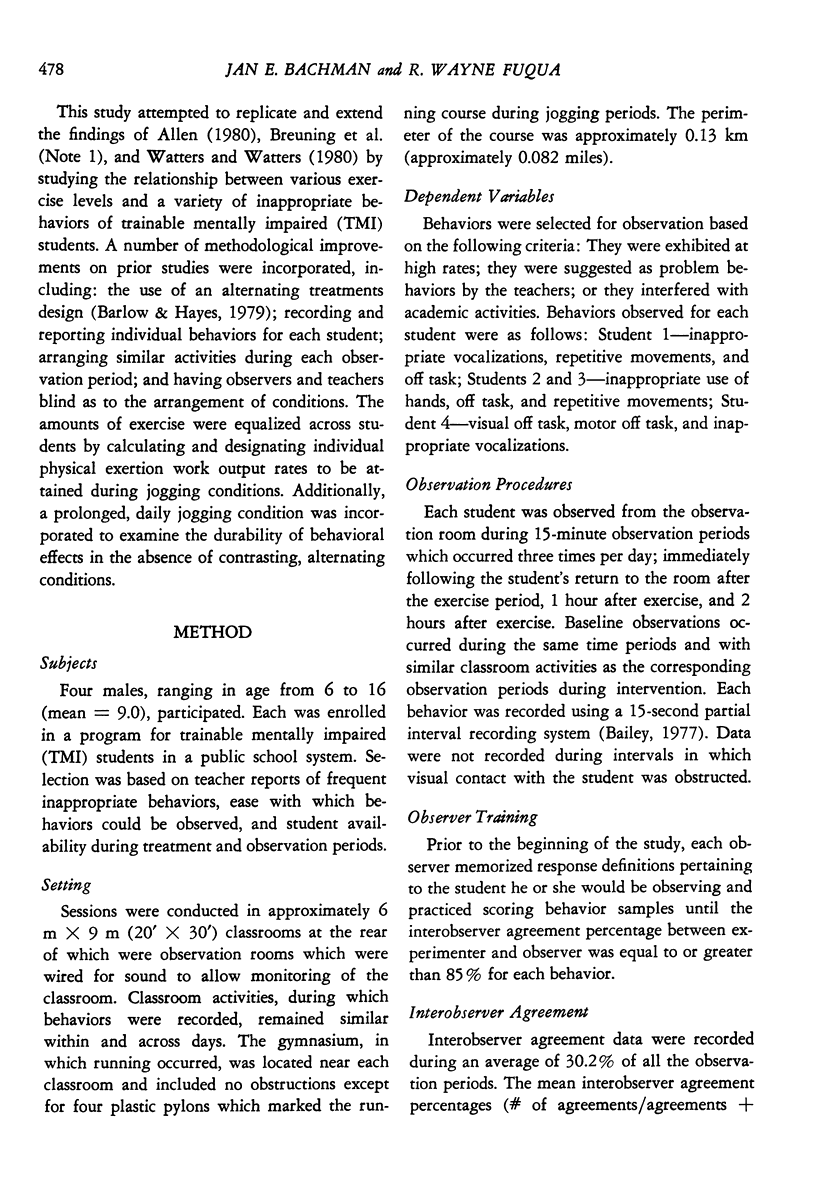Abstract
The effects of several levels of exercise on inappropriate behaviors of four trainable mentally impaired students were observed. Treatment conditions, which occurred as the first daily activity, included: Phase I, daily alternating conditions of warm-up exercises and jogging at a moderate rate for a short distance; Phase II, daily alternating conditions of no-exercise periods and jogging at a vigorous rate for a moderate distance; and Phase III, jogging at a vigorous rate for a moderate distance on consecutive days. For one student two additional conditions occurred, Phase IV, long-distance jogging on consecutive days at a vigorous rate and Phase V, consecutive days of no exercise. Observations of three inappropriate behaviors of each student occurred immediately after, 1 hour after, and 2 hours after each exercise period. Results indicate a decrease in all three inappropriate behaviors for three of four students and an inverse relationship between the level of exercise and the amount of inappropriate behavior for three of four students. Improvements over existing studies are discussed with suggestions for future research.
Full text
PDF







Selected References
These references are in PubMed. This may not be the complete list of references from this article.
- Baer D. M., Wolf M. M., Risley T. R. Some current dimensions of applied behavior analysis. J Appl Behav Anal. 1968 Spring;1(1):91–97. doi: 10.1901/jaba.1968.1-91. [DOI] [PMC free article] [PubMed] [Google Scholar]
- Barlow D. H., Hayes S. C. Alternating treatments design: one strategy for comparing the effects of two treatments in a single subject. J Appl Behav Anal. 1979 Summer;12(2):199–210. doi: 10.1901/jaba.1979.12-199. [DOI] [PMC free article] [PubMed] [Google Scholar]
- Folkins C. H., Sime W. E. Physical fitness training and mental health. Am Psychol. 1981 Apr;36(4):373–389. doi: 10.1037//0003-066x.36.4.373. [DOI] [PubMed] [Google Scholar]
- Horner R. D. The effects of an environmental "enrichment" program on the behavior of institutionalized profoundly retarded children. J Appl Behav Anal. 1980 Fall;13(3):473–491. doi: 10.1901/jaba.1980.13-473. [DOI] [PMC free article] [PubMed] [Google Scholar]
- Melin L., Götestam K. G. The effects of rearranging ward routines on communication and eating behaviors of psychogeriatric patients. J Appl Behav Anal. 1981 Spring;14(1):47–51. doi: 10.1901/jaba.1981.14-47. [DOI] [PMC free article] [PubMed] [Google Scholar]
- Wahler R. G., Fox J. J. Setting events in applied behavior analysis: Toward a conceptual and methodological expansion. J Appl Behav Anal. 1981 Fall;14(3):327–338. doi: 10.1901/jaba.1981.14-327. [DOI] [PMC free article] [PubMed] [Google Scholar]
- Watters R. G., Watters W. E. Decreasing self-stimulatory behavior with physical exercise in a group of autistic boys. J Autism Dev Disord. 1980 Dec;10(4):379–387. doi: 10.1007/BF02414814. [DOI] [PubMed] [Google Scholar]
- Whalen C. K., Henker B., Collins B. E., Finck D., Dotemoto S. A social ecology of hyperactive boys: medication effects in structured classroom environments. J Appl Behav Anal. 1979 Spring;12(1):65–81. doi: 10.1901/jaba.1979.12-65. [DOI] [PMC free article] [PubMed] [Google Scholar]


